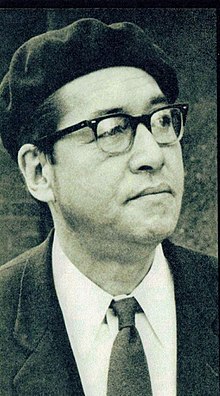Kōzaburō Yoshimura
Kōzaburō Yoshimura | |
|---|---|
 Yoshimura in January 1967 (age 55) | |
| Born | 9 September 1911 |
| Died | 7 November 2000 (aged 89) Yokohama, Kanagawa, Japan |
| Other names | Kimisaburo Yoshimura |
| Occupation | Film director |
| Years active | 1929-1974 |
Kōzaburō Yoshimura (吉村 公三郎, Yoshimura Kōzaburō, 9 September 1911 – 7 November 2000) was a Japanese film director.
Born in Shiga Prefecture, he joined the Shōchiku studio in 1929.[2] He debuted as director in 1934, but continued working as an assistant director for such filmmakers as Yasujirō Ozu and Yasujirō Shimazu after that. It was the 1939 film that established his status as a director.[1][2] During the Sino-Japanese war he directed a number of military dramas such as The Legend of Tank Commander Nishizumi (1940), based on a true story, for which he toured the actual battlefields in China.[3] His 1947 work, A Ball at the Anjo House, starring Setsuko Hara, was named the best picture of the year by Kinema Junpo.[1] That film marked the start of a long relationship with the screenwriter and film director Kaneto Shindō. In 1950, the two of them started the independent production company Kindai Eiga Kyokai.[1][2]
Yoshimura is credited with furthering the careers of such actresses as Fujiko Yamamoto, Machiko Kyō and Ayako Wakao.[1] He directed over 60 films during his career,[4] and received a Medal of Honor (Purple Ribbon) from the Japanese government in 1976.[1]
Selected filmography[]
- (暖流) (1939)
- The Legend of Tank Commander Nishizumi (1940)[5]
- The Spy isn't Dead Yet (1942)[6]
- A Ball at the Anjo House (安城家の舞踏会, Anjō-ke no butōkai) (1947)
- The Tale of Genji (1951)
- (1953)
- Epitome (1953) (producer only)
- Life of a Woman (1953) (producer only)
- An Osaka Story (1957)
- (女の坂) (A Woman's Uphill Slope) (1960)
- Jokyo (1960)
References[]
- ^ Jump up to: a b c d e f "Obituary: Kozaburo Yoshimura". Japan Times. Retrieved 26 July 2010.
- ^ Jump up to: a b c "Yoshimura Kōzaburō". Nihon jinmei daijiten (in Japanese). Kōdansha. Retrieved 4 December 2010.
- ^ High, Peter B. (2003). The Imperial Screen. Wisconsin Studies in Film. The University of Wisconsin Press. pp. 211–217. ISBN 0-299-18134-0.
- ^ "Yoshimura Kōzaburō". Japanese Movie Database (in Japanese). Retrieved 4 December 2010.
- ^ High, Peter B. (2003). The Imperial Screen. Wisconsin Studies in Film. The University of Wisconsin Press. pp. 167–168, 211–213. ISBN 0-299-18134-0.
- ^ High, Peter B. (2003). The Imperial Screen. Wisconsin Studies in Film. The University of Wisconsin Press. pp. 444–445. ISBN 0-299-18134-0.
External links[]
- 1911 births
- 2000 deaths
- Japanese film directors
- People from Ōtsu, Shiga
